Shrubs of the Adirondacks:
Sweetgale (Myrica gale)
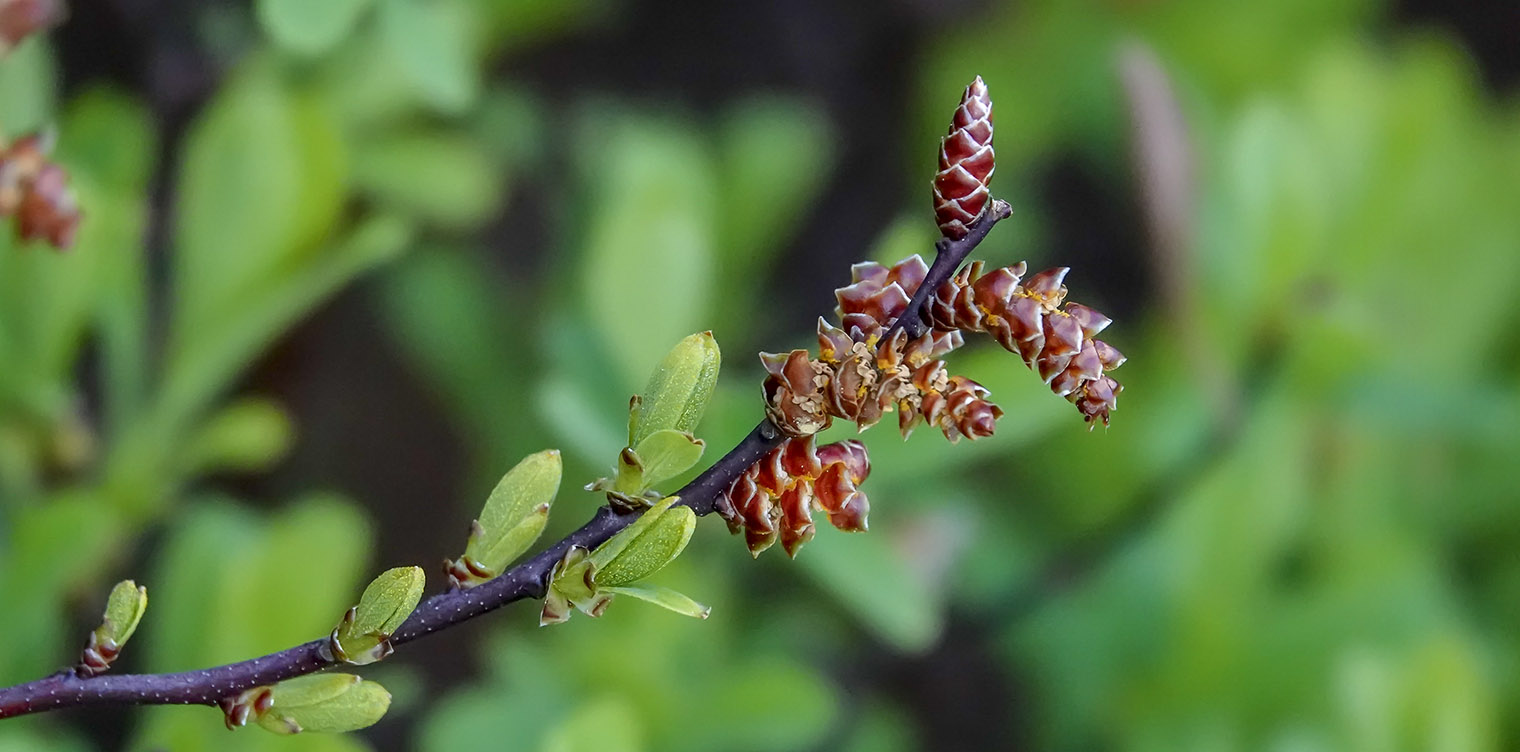
Sweetgale or Bog Myrtle (Myrica gale) is a deciduous aromatic shrub that grows in marshes, bogs, and the edges of lakes and ponds in the Adirondack Mountains.
Sweetgale is part of the Myricaceae family, which also includes two other plants that occur in the Adirondacks: Sweet Fern (Comptonia peregrina) and Bayberry (Morella caroliniensis).
- Sweetgale is part of the Myrica genus; it is the only member of this genus which occurs in New York State.
- The nonscientific name – Sweetgale – is a reference to the fragrance the leaves and twigs exude when bruised. Other nonscientific names for this species include Sweet-gale, Sweet Bayberry, Bog Myrtle, Bog Gale, Meadow-fern, and Dutch Myrtle.
Identification of Sweetgale
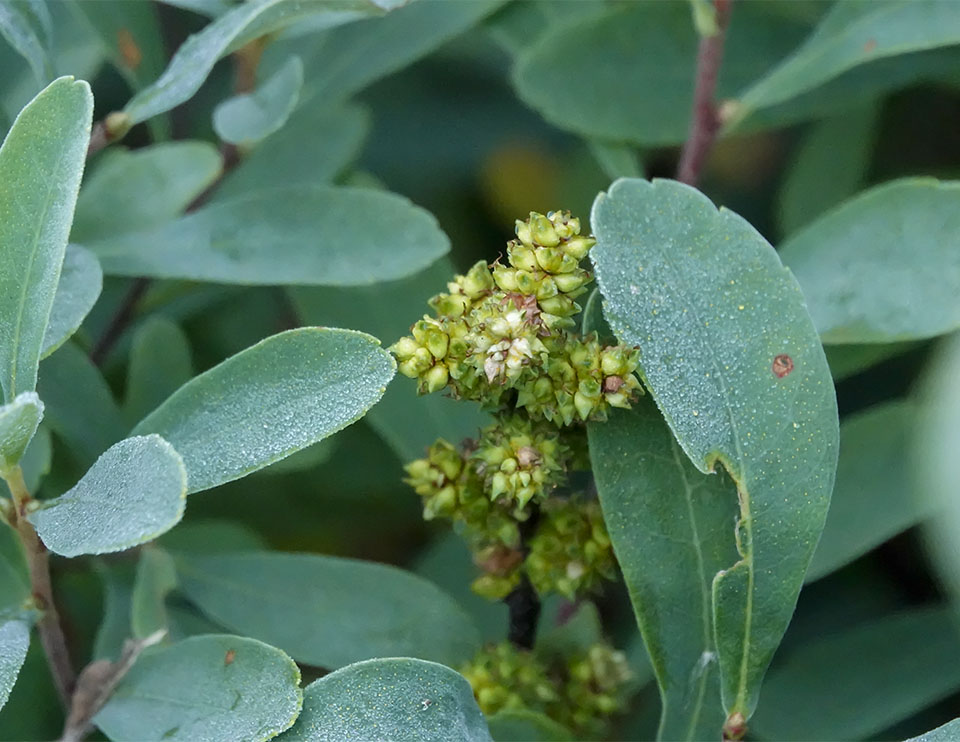
Sweetgale is a deciduous shrub that grows about two to five feet tall. Its multiple stems and branches often form dense patches. The plant spreads vegetatively by both branch layering and rooted suckers, often creating large island of plants. The roots have nitrogen-fixing nodules which allow it (in conjunction with bacteria) to convert nitrogen to a form useful to plants.
The twigs are slender and hairless, with resin dots. The reddish brown bark has pale-brown lenticelsLenticels: A series of pores on stem of a woody plant which allows the direct exchange of gases between the atmosphere and the internal tissues of the plant. These pores appear as small spots, dots, or lines, the shape of which is used as a clue to the plant's identification.. The branchlets are fragrant when bruised.
The leaves of Sweetgale are deciduous.
- The leaves are
simple
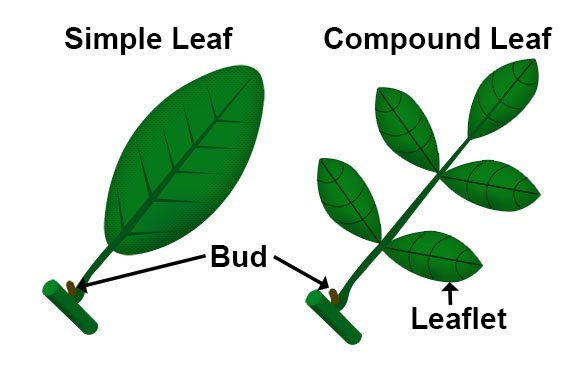 Simple Leaf: A leaf with a single undivided blade, as opposed to a compound leaf, which is one that is divided to the midrib, with distinct, expanded portions called leaflets., meaning that each leaf has a single blade.
Simple Leaf: A leaf with a single undivided blade, as opposed to a compound leaf, which is one that is divided to the midrib, with distinct, expanded portions called leaflets., meaning that each leaf has a single blade. - The leaves are arranged in an alternate
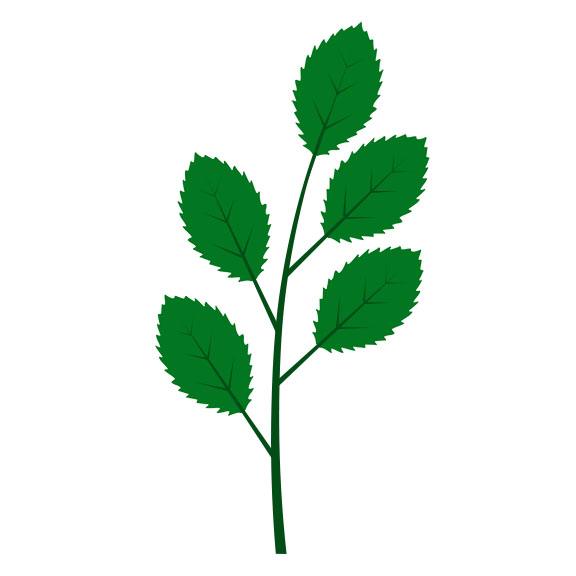 Alternate: An arrangement of leaves (or buds) on a stem (or twig) in which the leaves emerge from the stem one at a time. This often makes the leaves appear to alternate on the stem. fashion, meaning that the leaves emerge from the stem one at a time, rather than in pairs.
Alternate: An arrangement of leaves (or buds) on a stem (or twig) in which the leaves emerge from the stem one at a time. This often makes the leaves appear to alternate on the stem. fashion, meaning that the leaves emerge from the stem one at a time, rather than in pairs. - The leaves are ¾ to 2½ inches long and ⅓ to ¾ inch wide. The leaf blade
.jpg) The flat portion of a leaf, petal, or sepal. is widest above the middle, tapering to the base.
The flat portion of a leaf, petal, or sepal. is widest above the middle, tapering to the base. - The edges (marginsThe structure of the leaf's edge.) of the leaves are so minutely toothed
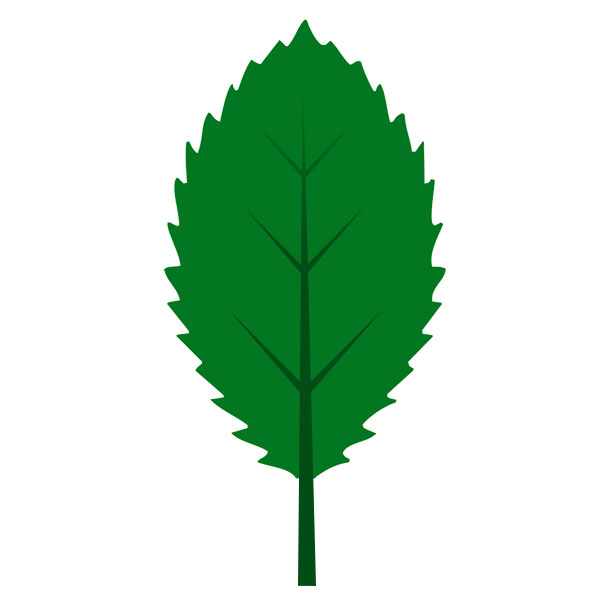 Toothed: Leaves which have a saw-toothed edge. that they appear to be smooth
Toothed: Leaves which have a saw-toothed edge. that they appear to be smooth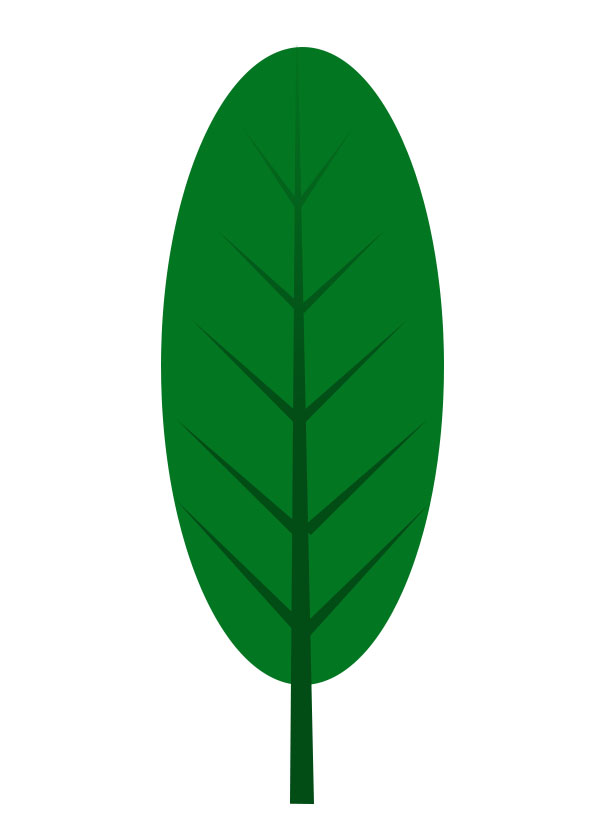 Smooth leaf edges do not have any teeth., except for the tip of the leaf which has several pairs of shallow, rounded teeth.
Smooth leaf edges do not have any teeth., except for the tip of the leaf which has several pairs of shallow, rounded teeth. - The leaves are slightly paler on the underside, but both sides are covered with tiny golden resin dots, which exude a spicy odor when crushed.
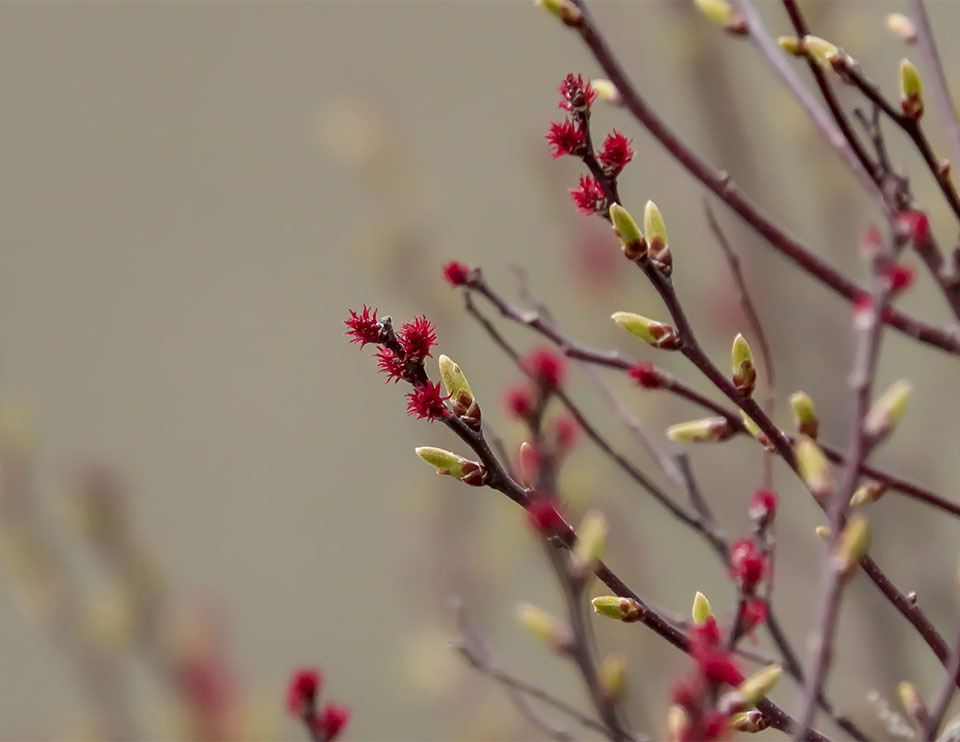
Sweetgale's flowers are small catkinsCatkin: A slim, cylindrical flower cluster of many, usually single-sex flowers. They have scaly bracts and usually lack petals. Many trees and shrubs, including birch, willow, hornbeams, poplar, and hickory, bear catkins. which appear before the leaves emerge. Male and female flowers are mostly borne separately on different plants. Male catkins form from the lateral buds at the tips of one-year-old twigs. They are cylindrical, about ¼ to ⅓ inch long; they are yellow with triangular, reddish scales.
The female flowers are slightly smaller. They also form from lateral buds at the tips of one-year-old twigs. They consist of 15 to 25 tiny flowers, each with two red stigmas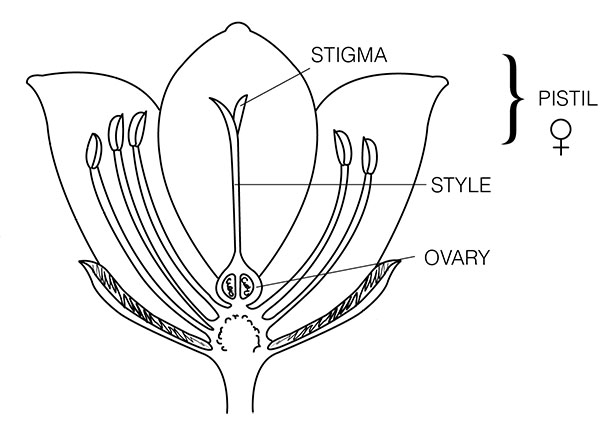 Stigma: part of the pistil, which is the seed-producing, or female, unit of a flower. The stigma is the tip of the pistil, where the pollen lands. supported by oval bracts. The effect is that of fluffy, bright red tufts.
Stigma: part of the pistil, which is the seed-producing, or female, unit of a flower. The stigma is the tip of the pistil, where the pollen lands. supported by oval bracts. The effect is that of fluffy, bright red tufts.
Throughout its range, Sweetgale flowers in spring to early summer. A tally of flowering dates for the upland Adirondack areas compiled by Michael Kudish, based on data collected from the early seventies to the early nineties, lists flowering dates from 4 May to 10 May. More recent data from the limited number of observations in the Adirondack Park in the iNaturalist data base suggest a similar pattern, with most bloom observations in late April and early May.
Sweetgale's catkins develop into fruit in the form of small cylindrical clusters. Each cluster is made up of winged nutlets, each about ⅛ long. The fruits are surrounded by spongy bractlets that act as flotation devices in water. These aid in their dispersal to other wet habitats. The fruits ripen in July.
Uses of Sweetgale
Sweetgale had a number of traditional uses in northern and western Europe, where is also native. Until the 16th century, it was used as a flavoring for beer. Other regions used it as an insect repellent or as an ingredient in some soaps. Leaves and nutlets were also used as a tea or as a seasoning, although the essential oil is considered toxic in large doses. The plant has been listed as an abortifacient and contraindicated for pregnant women.
Sweetgale was also used by a very limited extent by native American groups. The Bella Colla, for instance, used a decoction of pounded branches as a diuretic. The Potawatomi used it to line blueberry pails to keep berries from spoiling. The Ojibwa obtained brown and yellow dyes from the branch tips or seeds.
Wildlife Value of Sweetgale
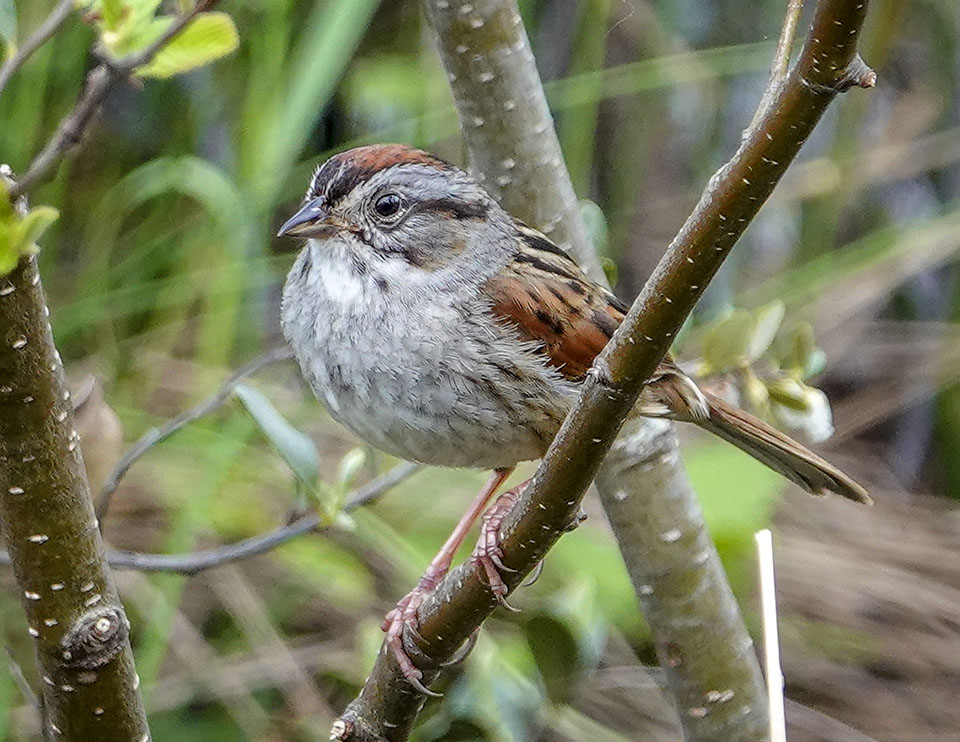
Sweetgale's value to wildlife is relatively limited. It serves as a summer food source for a few species of birds, such as American Tree Sparrows. Sweetgale also serves as a nest site for White-throated Sparrows and Swamp Sparrows. Ring-necked Ducks have also been observed nesting in thickets of Sweetgale.
Sweetgale is of minimal importance as a food source for mammals. Muskrats and White-tailed Deer reportedly feed on the leave occasionally, but it is not a major food source for either of these animals.
Sweetgale plays a somewhat more important role with regard to insects. Its leaves serve as a larval host for a wide variety of moths, including sphynx moths, tortricid moths, tiger moths, owelet moths, and pyralid moths. The list of moth larvae found feeding on Sweetgale foliage in the Adirondack region includes the Chain-dotted Geometer (Cingilia catenaria), Spear-Marked Black Moth (Rheumaptera hastata), Apple sphinx (Sphinx gordius), and White-marked Tussock Moth (Orgyia leucostigma).
Distribution of Sweetgale
In North America, Sweetgale is found throughout Canada and in the northeastern US, south to North Carolina and west to Wisconsin and Minnesota. It also occurs in Washington and Oregon. It is listed as endangered in North Carolina and threatened in Pennsylvania.
In New York State, Sweetgale is found in all counties in the northeastern third of the state. Vouchered plant specimens have been registered for all counties within the Adirondack Park Blue Line.
Habitat of Sweetgale
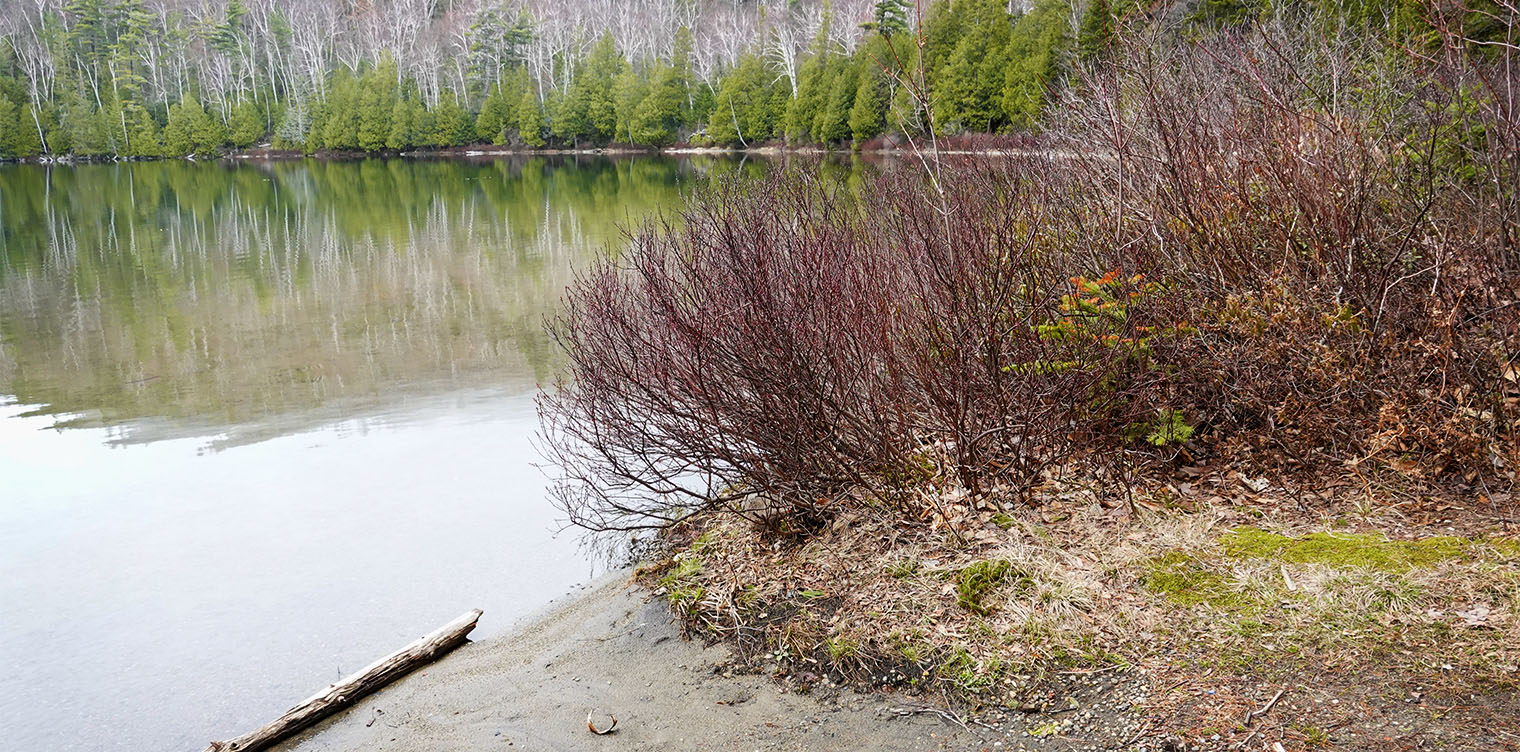
Sweetgale is classified as an obligate wetland plant (OBL)Obligate Wetland Plant (OBL): Plants that almost always occur in wetlands. These plants (herbaceous or woody) are found in standing water or seasonally saturated soils (14 or more consecutive days) near the surface. This category includes submerged plants (such as pondweeds), floating plants (such as Common Duckweed), floating-leaved plants (such as White Water Lily and Yellow Pond Lily), and emergent plants (such as Pickerelweed)., meaning that it almost always occurs in wetlands. Throughout its range, it occurs in moist, peaty soils in bogs, fens, coastal and inland swamps, and along the borders of lakes, ponds, and streams. It may become a dominant shrub species in these habitats
In the Adirondack region, Sweetgale is found in a wide variety of wetland ecological communities, including:
- Inland Calcareous Lake Shore
- Inland Non-calcareous Lake Shore
- Inland Poor Fen
- Medium Fen
- Oxbow Lake/Pond
- Rich Graminoid Fen
- Rich Shrub Fen
- Riverside Ice Meadow
- Sedge Meadow
Look for Sweetgale growing in sunny areas along lake shores. Among the trails covered here, the most convenient place to find Sweetgale is along the shore of Heart Lake Trail, where it can be seen growing near Mountain Holly.
References
Michael Kudish. Adirondack Upland Flora: An Ecological Perspective (The Chauncy Press, 1992), p. 116.
New York Flora Association. New York Flora Atlas. Myrica. Retrieved 21 March 2020.
New York Flora Association. New York Flora Atlas. Sweetgale. Myrica gale. Retrieved 21 March 2020.
New York Flora Association. New York Flora Atlas. Myricaceae. Retrieved 22 March 2020.
New York Flora Association. New York Flora Atlas. Sweet Fern. Comptonia peregrina. Retrieved 22 March 2020.
New York Flora Association. New York Flora Atlas. Bayberry. Morella caroliniensis. Retrieved 22 March 2020.
Integrated Taxonomic Information System. Myrica gale. Retrieved 21 March 2020.
United States Department of Agriculture. The Plants Database. Sweetgale. Myrica gale. Retrieved 21 March 2020.
Flora of North America. Myrica gale. Retrieved 21 March 2020.
Northern Forest Atlas. Images. Sweet Gale. Myrica gale. Retrieved 21 March 2020.
Margaret B. Gargiullo. A Guide to Native Plants of the New York City Region (New York City Department of Parks & Recreation, 2007), p. 96.
Native Plant Trust. Go Botany. Sweetgale. Myrica gale. Retrieved 21 March 2020.
New York State. Department of Environmental Conservation. New York Natural Heritage Program. Ecological Communities of New York State. Second Edition (March 2014), pp. 50-51, 55-56, 58-61. Retrieved 17 October 2015.
New York Natural Heritage Program. 2020. Online Conservation Guide for Inland Calcareous Lake Shore. Retrieved 21 March 2020.
New York Natural Heritage Program. 2020. Online Conservation Guide for Inland Poor Fen. Retrieved 21 March 2020.
New York Natural Heritage Program. 2020. Online Conservation Guide for Medium Fen. Retrieved 21 March 2020.
New York Natural Heritage Program. 2020. Online Conservation Guide for Oxbow Lake/Pond. Retrieved 21 March 2020.
New York Natural Heritage Program. 2020. Online Conservation Guide for Rich Graminoid Fen. Retrieved 21 March 2020.
New York Natural Heritage Program. 2020. Online Conservation Guide for Rich Shrub Fen. Retrieved 21 March 2020.
New York Natural Heritage Program. 2020. Online Conservation Guide for Riverside Sand/Gravel Bar. Retrieved 21 March 2020.
New York Natural Heritage Program. 2020. Online Conservation Guide for Sedge Meadow. Retrieved 21 March 2020.
New York State. Adirondack Park Agency. Preliminary List of Species Native Within the Adirondack Park Listed Alphabetically by Scientific Name and Sorted by Habit. Volume 1. Updated 10.23.2006, p. 10. Retrieved 26 January 2017.
University of Wisconsin. Flora of Wisconsin. Meadow-fern. Myrica gale. Retrieved 21 March 2020.
Minnesota Wildflowers. Sweet-gale. Myrica gale. Retrieved 21 March 2020.
Illinois Wildflowers. Plant-Feeding Insect Database. Sweet Gale. Myrica gale. Retrieved 21 March 2020.
iNaturalist. Myrica. Retrieved 21 March 2020.
iNaturalist. Bog Myrtle. Myrica gale. Retrieved 21 March 2020.
iNaturalist. Adirondack Park Observations. Bog Myrtle. Myrica gale. Retrieved 21 March 2020.
Meiyin Wu & Dennis Kalma. Wetland Plants of the Adirondacks: Ferns, Woody Plants, and Graminoids (Trafford Publishing, 2011), p. 80.
William K. Chapman and Alan E. Bessette. Trees and Shrubs of the Adirondacks: A Field Guide (Utica, New York: North Country Books, 1990), pp. 111, Plate 33.
James H. Soper and Margaret L. Heimburger. Shrubs of Ontario (Royal Ontario Museum, 1982), pp. 88-91. Retrieved 21 March 2020.
Donald W. Stokes. The Natural History of Wild Shrubs and Vines. Eastern and Central North America (Harper & Row, Publishers, 1981), pp. 17-20. Retrieved 20 March 2020.
John Eastman. The Book of Swamp and Bog: Trees, Shrubs, and Wildflowers of Eastern Freshwater Wetlands (Stackpole Books, 1995), pp. 186-188.
John Eastman. The Eastman Guide to Birds: Natural History Accounts for 150 North American Species (Stackpole Books, 2000), pp. 234-240.
Plants for a Future. Myrica gale. Retrieved 21 March 2020.
Steven Foster and James A. Duke. A Field Guide to Medicinal Plants and Herbs of Eastern and Central North America. Second Edition. (Houghton Mifflin Harcourt, 2000), pp. 285-286. Retrieved 17 December 2019.
Lee Allen Peterson. A Field Guide to Edible Wild Plants. Eastern and Central North America (Houghton Mifflin Company, 1977), pp. 206-207.
University of Michigan. Native American Ethnobotany. A Database of Foods, Drugs, Dyes and Fibers of Native American Peoples, Derived from Plants. Sweetgale. Myrica gale. Retrieved 21 March 2020.
The Cornell Lab of Ornithology. Birds of the World. Subscription web site. American Black Ducks, American Tree Sparrows, Greater Yellowlegs, Lesser Yellowlegs, Sandhill Crane, Semipalmated Sandpipers, Snow Geese, Swamp Sparrows, White-throated Sparrows, Wilson's Snipe. Retrieved 21 March 2020.
Iowa State University. BugGuide. Acleris bowmanana, Acleris fragariana, Acleris kearfottana, Acrobasis comptoniella, Archips myricana, Catocala badia coelebs, Coenophila opacifrons, Condylolomia participalis, Eurois occulta, Genus Condylolomia, Genus Mesothea, Macaria sulphurea, Mesothea incertata, Northern Apple Sphinx. Sphinx poecila, Olethreutes valdanum, Phragmatobia fuliginosa, Prolimacodes badia. Retrieved 21 March 2020
Allen J. Coombes. Dictionary of Plant Names (Timber Press, 1994), p. 122.
Timothy L. McCabe. Atlas of Adirondack Caterpillars. With a Host List, Rearing Notes and a Selected Bibliography of Works Depicting Caterpillars. (New York State Museum Bulletin No. 470, 1991), pp. 5-6, 8-11, 13, 15-18. Retrieved 22 February 2017.
Charles H. Peck. Plants of North Elba. (Bulletin of the New York State Museum, Volume 6, Number 28, June 1899), p. 122. Retrieved 22 February 2017.
Saratoga Woods and Waterways. 25 February 2020, 20 February 2019, 3 August 2018, 20 July 2018, 30 July 2017, 1 March 2017, 22 February 2017, 7 February 2017, 11 July 2016, 26 January 2016, 18 January 2016, 14 December 2016, 6 May 2011, 1 May 2010, 14 April 2010, 3 February 2010, 12 January 2010, 30 May 2009, 28 April 2009, 16 April 2009, 20 February 2009. Retrieved 22 March 2020.
Shrubs of the Adirondack Park
